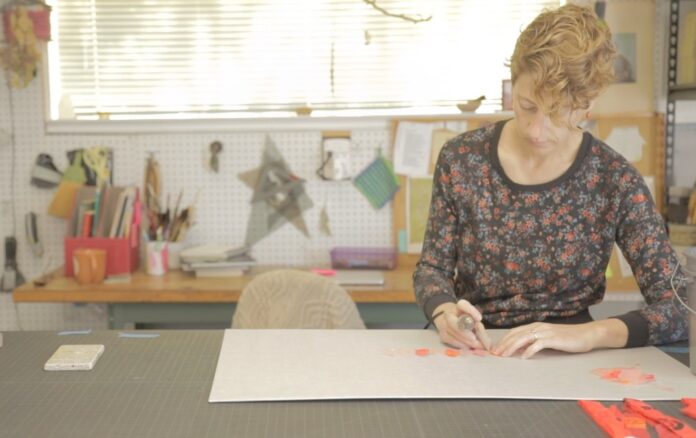“As an artist and mother of two young daughters, I was at a pivotal point where I needed to discover new parts of myself and to heal past wounds that were holding me back. I saw in California the chance to start over and to redefine who I wanted to be,” multidisciplinary artist Katie Murken told 48hills.
Currently based in Alameda, Murken grew up in Pittsburgh’s South Hills suburb, Peters Township. She distinctly remembers exploring its mix of forest, farm, and new upper middle-class developments. After living in different places in Pennsylvania until 2018, a decision was made to move to the Bay Area when her husband was offered a position with his company’s foundry, which was based in San Francisco. There were other offers in Pennsylvania, but something called them west.
California provided opportunities, she says, to learn from people fighting for the environment, human rights, and political change; access to art organizations of every kind; and a different physical environment.
“I had never lived close to open water before and I knew these surroundings would be healing on so many levels,” she said.
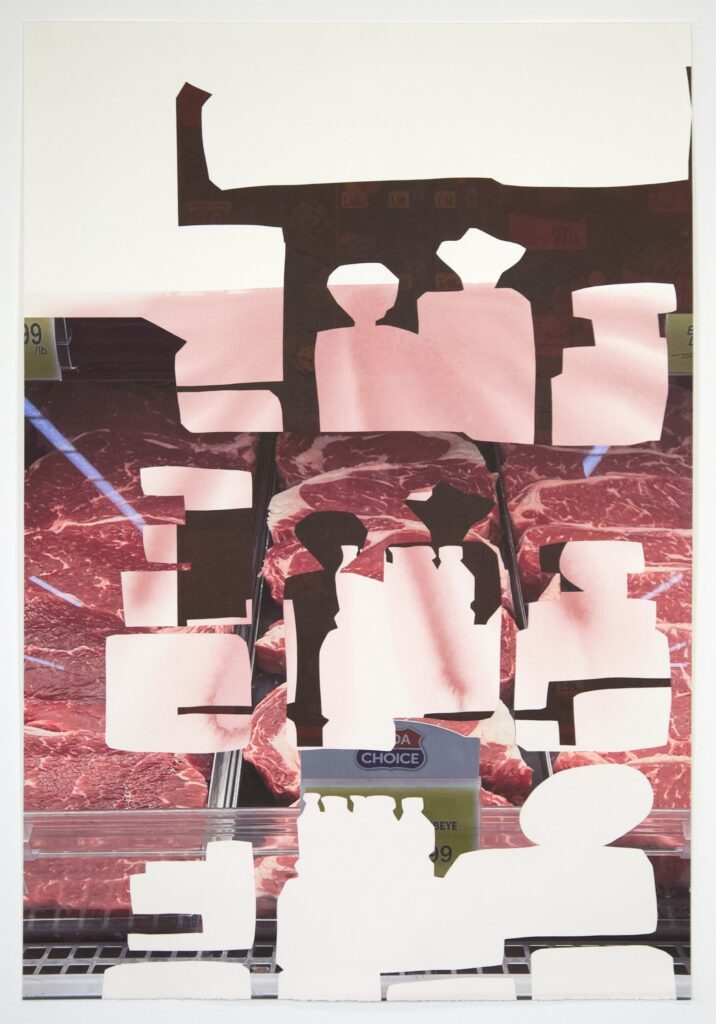
Murken’s creative path began when she was young, with an introduction to art theory and method with classes in drawing and painting in the pre-college arts program at Carnegie Mellon University in Pittsburgh.
“I felt so independent going into the city to study art in this amazing institution where Andy Warhol also first started his arts education,” she said.
She later graduated with honors from Penn State University (BFA, 2002), and describes those years as formative, not only because of the education she received and the faculty she worked with, but for the school’s surrounding landscape. During her senior year, she took a book arts class with Charles S. Cave, which influenced her path going forward in regards to the relationship between two and three-dimensional forms. Murken went on to complete an MFA in book arts and printmaking at the University of the Arts in Philadelphia in 2005, one of few programs that focus on the disciplines of book arts, printmaking, and papermaking.
“I was introduced to and encouraged to synthesize a broad range of disciplines through a rigorous studio practice and thesis exhibition. I also had the opportunity to work in several conservation labs around the city of Philadelphia, including the American Philosophical Society and the Library Company of Philadelphia,” Murken said.
Due to such unique qualifications, Murken was hired as an adjunct faculty at Tyler School of Art at Temple University in Philadelphia in 2006 and swiftly promoted to a full-time position as an associate professor in the foundations department. Murken taught courses in 2D design, printmaking, and digital design, and also founded the very first book arts course at Tyler, which is still part of its printmaking department’s offerings to this day.
Murken says the Bay Area art community has both welcomed and challenged her. With so many talented and hard-working artists, she says she discovers diverse practices every time she ventures out.
“I love that there is a deep sense of commitment to larger causes, both on the individual and institutional level—including feminism, environmentalism, BIPOC and LGBTQ rights, as well as claiming space and uplifting the voices of artists with disabilities,” she said.
Inspired by artists like Rosie Lee Tompkins and Andres Guerrero, Murken schedules time every month to visit galleries, attend talks, and support artists any way she can, saying it is not only a way to invigorate her own art practice but a reminder that she is just one of numerous artists deserving of opportunity and recognition in the Bay Area.
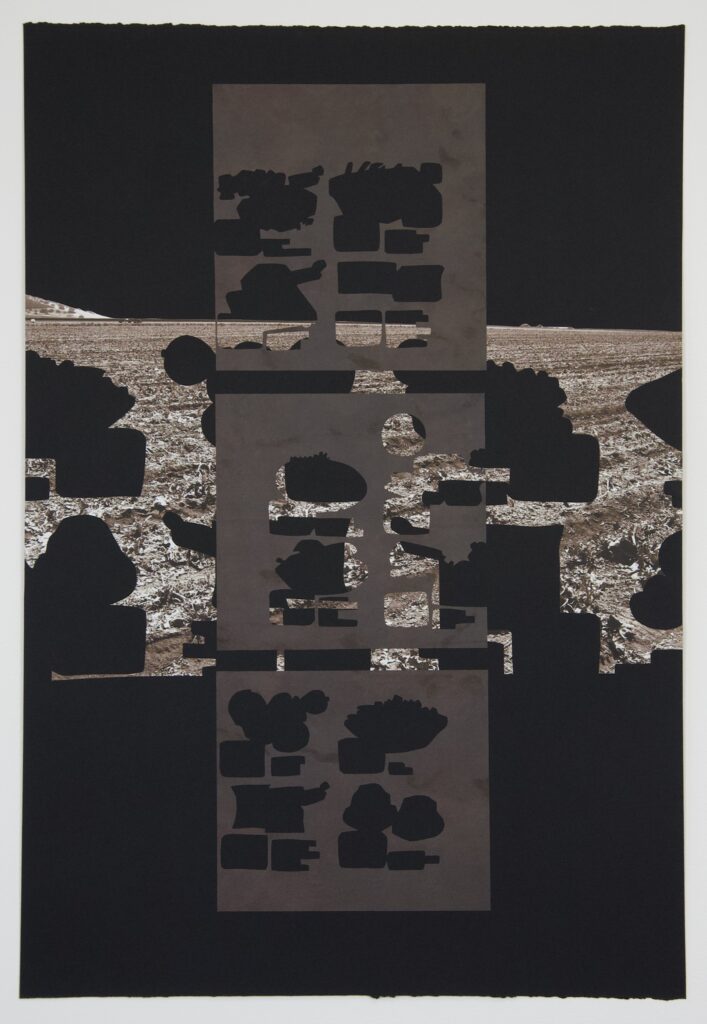
“This keeps me inspired and motivated to make work that is authentic to who I am and is a unique offering to the vibrancy I see around me,” she said.
Among her favorite outings are a visit to Minnesota Street Project, a drink at Besharam, and a stroll down the pathway garden leading to Altman Siegel Gallery, Slash Art, and (the recently closed) McEvoy Foundation. She is also inspired by the work done through NIAD Art Center and Creative Growth in the East Bay and Creativity Explored in San Francisco, saying that bringing recognition to mental health is one of the primary driving forces in her work.
Murken is also motivated by visits to the annual FOG Design + Art Fair, exhibitions at SFO, BAMPFA, Anthony Meier Gallery, and Round Weather Gallery. Murken gives a shout out to the Mission District and all of the local galleries that have supported her work, most specifically Analog Gallery—with whom she connected online during the pandemic—The Drawing Room, MAG Galleries, MRKT Gallery, and The Great Highway, which invited her to do her first solo exhibition in the Bay Area in 2022.
Inwardly, Murken’s work is guided by the desire to bring recognition to injustices to women and the reverberating effect this has on the collective health of our society, our environment, and our world.
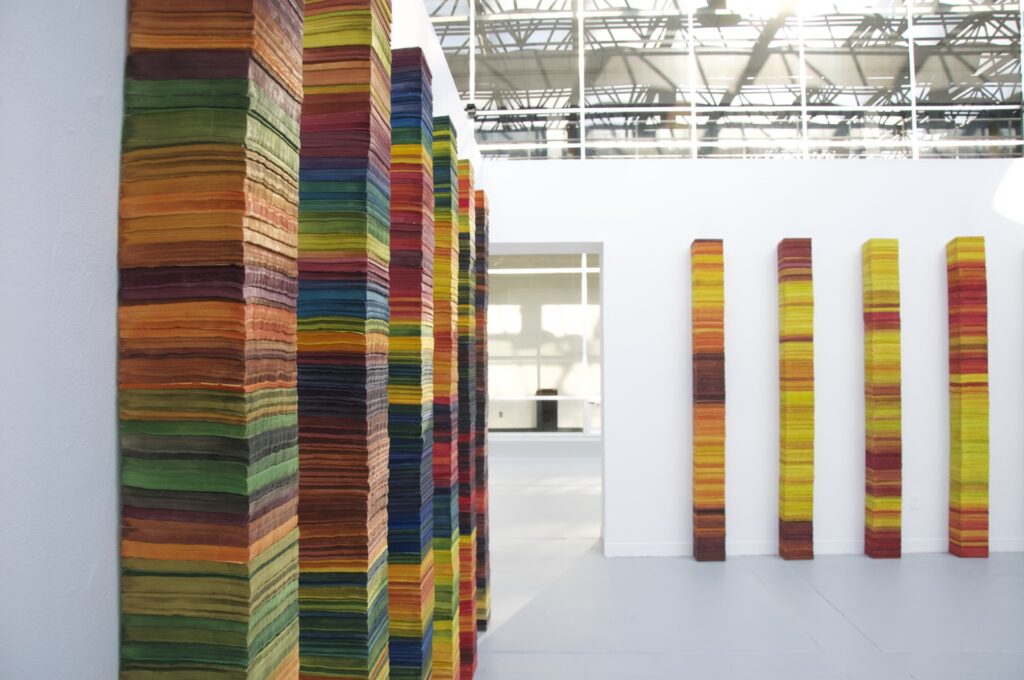
“I dedicate my work to mothers who are struggling with mental illness, with the hope that my creations help them to know that they are not alone, that they are worthy and that transformation paves the way to healing. I am inspired by my own mother who, despite her struggles with mental illness, modeled for me the deep connection between motherhood, creativity, and the natural world,” Murken said.
Murken works primarily with found materials, exploring their transformative possibilities and how that process reflects the inner transformation necessary for healing in both metaphorical and alchemical ways.
She believes that consumerism and capitalism place a particular kind of burden on women and that by deconstructing particular objects and materials, she can make a visual statement about this overlooked connection. She wants us to recognize that “nothing is beyond redemption—not garbage, not society, and not us.” Her materials possess both personal and collective meaning.
“Telephone books, plastic bags and grocery ads conjure the abject, the aspects of a profit-driven society that feel utterly hopeless. It is not this hopelessness that is the subject of my work, but its transformation. How can I take something that has no use, no inherent beauty, no significance and through my creative process turn it into something that is empowering to myself and others? For me, this is a mirror to the process of healing the inner unworthiness that accompanies mental illness. It must be dissected and then reshaped and integrated into something that is whole and complete,” Murken said.
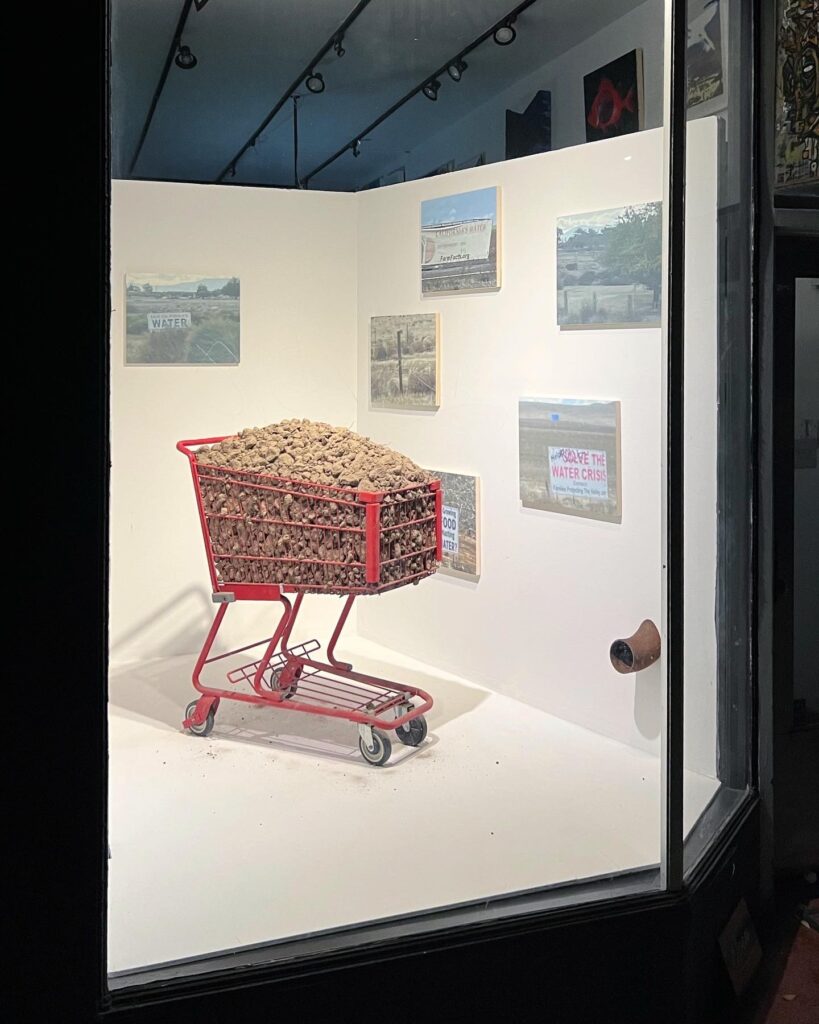
From the clean and open space of her West Oakland studio—a location she chose for its grit, industrial quality, and vibrant art community—the artist’s days flow seamlessly. Lately, she’s been working with grocery ads as a starting point.
“I spend a lot of time tracing the image and text blocks from the ads, using these drawings as templates for stencils that I cut into other materials. Sometimes I cut the ads themselves and sometimes I trace the shapes onto other materials, like dyed paper or photographs that I’ve taken. These all become materials that I use in my collage work,” she said.
Some days she works digitally, editing photos or scanning and printing large scale images on equipment at Kala Art Institute in Berkeley. Once she has a collection of materials to work with, she begins the process of arranging.
“I love collage because I can move things around until I am satisfied. I’m not happy with images that simply look pretty or are visually satisfying. There has to be tension, whether it’s conceptual or compositional, it is an important part of my message about transformation,” she said.
Murken claims to get bored easily, so it’s important to her to vary her practice. She is vigilant when it comes to avoiding repetitive stress injuries, a big risk in the type of focused hand work involved in her process. Moving between painting and drawing, cutting and collage, photography, sculpture and assemblage, and deconstructing materials provides the range of engagement she seeks.
The arc of her career has grown from experiencing her work as separate entities to a more unified, connective flow. She’s looking within versus towards exterior sources, and alternating control with spontaneity. Mirroring that, Murken says she is in the process of evolving from a fragmented sense of self to one of wholeness and integration.
“I don’t feel like I need to define each project with certain parameters and I’m allowing myself to take greater risks and to integrate failure so that I can discover a broader set of possibilities for each idea,” she said.
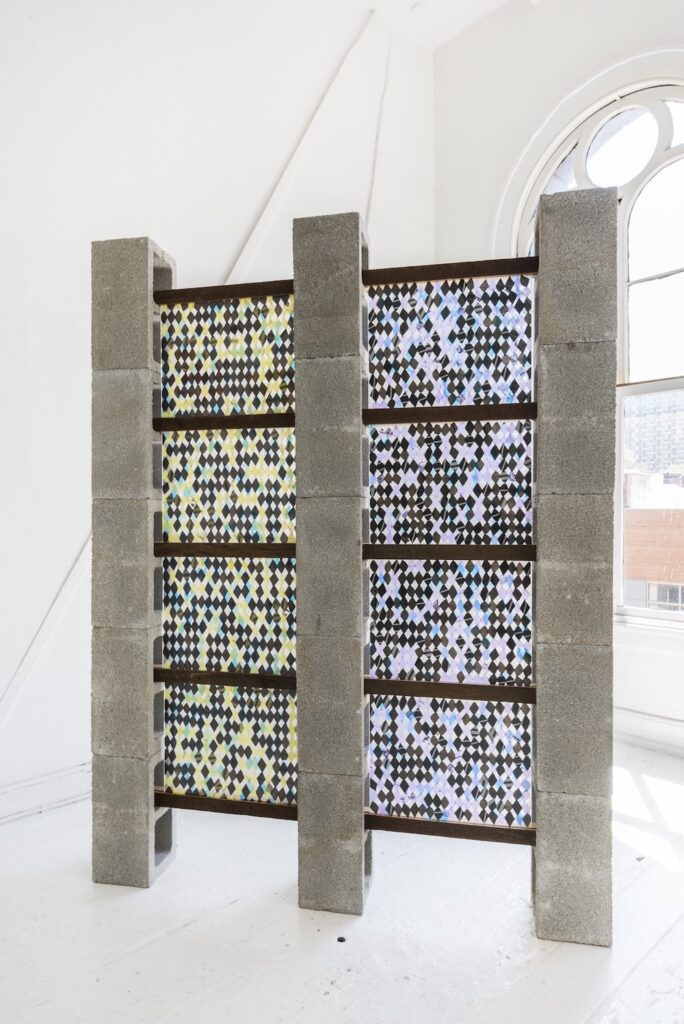
Murken has two exhibitions in the works. She will be part of the group show, “Synthetic Nature” at Upstart Modern in Sausalito from April 4 – May 22. And she is creating a series of mixed-media paintings and sculpture for a solo exhibition, “Dust to Dust” at MRKT Gallery, August 2 – August 31, taking the water wars happening across California as subject matter.
“Water is so powerful and identifies so strongly with the female body and the creation and sustenance of life. It’s a complicated issue, but these signs have direct emotional impact. There is a water crisis and it’s a battle between big business, government, the environment, and those who depend on it for survival, animals and people alike. I see this as a parallel issue to the ongoing subjugation of women represented by the struggles over reproductive rights,” Murken said.
She’s also started an intimate series of self-portraits for which she photographs herself nude, wrapped in barbed wire, a project she says has led her to research her ancestry and the legacies that are passed down.
“It’s a statement about intergenerational trauma and violence and its chain reaction that stems from the inner turmoil that’s been bound up inside of us over generations. It is vulnerable, yet powerful and I’m not sure yet how I’ll present the work. Maybe it’s just for me,” she said.
Katie Murken is a firm believer that we are all here on this earth to create, that art is not limited to something a person creates in a moment of inspiration. She says it exists in every interaction, every utterance, and especially in every moment of care given to others.
“I’ve spent my life trying to perfect my art, only to realize it was already perfect. I didn’t have to do anything special,” she said. “It’s more about paying attention to the acts that create positivity and working to heal the ones that don’t.”
For more information, visit Katie Murken’s website at katiemurken.com and on Instagram.


